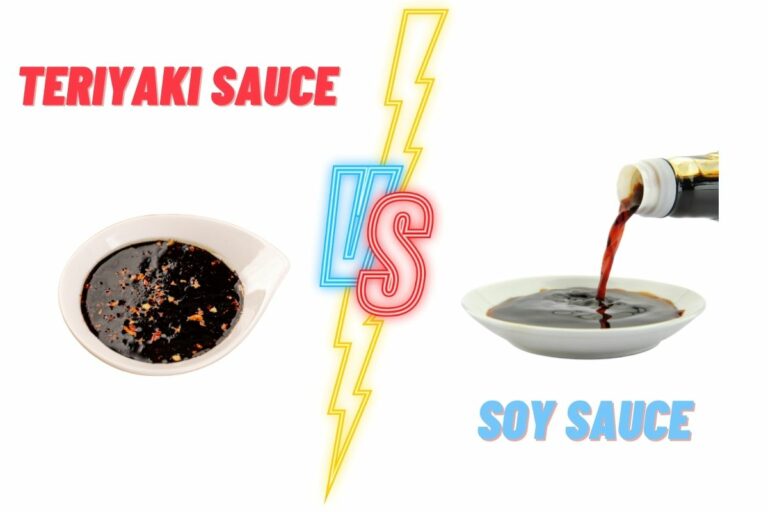6 Best Substitutes For Maggi Seasoning
Ever felt stuck when you ran out of Maggi seasoning in the middle of cooking? Recognized worldwide, this reliable kitchen companion enhances flavor in various dishes. But don’t worry! Our blog will guide you through some of the best alternatives that can be used as substitutes for Maggi seasoning.
Dive in and discover how these options could even become your new favorite secret ingredient!
Understanding the Role of Maggi Seasoning in Cooking
Maggi seasoning, a staple in Asian cuisine, is celebrated for its versatile flavor. This condiment acts as a flavour enhancer that adds depth and complexity to various dishes. From soups to stir-fries, marinades to sauces, it imparts a unique taste that’s hard to replicate.
The strength of Maggi seasoning lies in its robust combination of ingredients which include salt, water and spices among others. With its savory and slightly spicy undertone, it brings out the best from your food making it irresistible.
Devised by Swiss entrepreneur Julius Maggi in the late 19th century as an affordable way to enhance the taste of meals while adding nutrition value, this liquid goodness has gone on to become popular worldwide.
Today you will find multiple brands offering substitutes similar to Maggi seasoning with their own unique twist. Despite being so popular however, there are some health concerns related with regular usage of Maggi Seasoning due high sodium content and presence of monosodium glutamate (MSG).
Therefore finding appropriate substitutes for seasoning is necessary without compromising too much on flavor profile.
Popular Dishes Where Maggi Seasoning is Used
- Stir – fried noodles and vegetables
- Fried rice
- Beef or chicken stir – fry
- Soups, such as hot and sour soup or miso soup
- Marinated grilled or roasted meats
- Barbecue sauces and glazes
- Salads, especially Asian-inspired salads with soy sauce-based dressings
- Thai dishes, like Pad Thai or green curry
- Vietnamese dishes, like Pho or Banh Mi sandwiches
- Indonesian dishes, such as Nasi Goreng (fried rice) or Gado Gado (vegetable salad with peanut sauce)
- Chinese – style dumplings or potstickers
Impact of Monosodium Glutamate (MSG) in Maggi Seasoning
Monosodium glutamate (MSG) is a flavor enhancer commonly found in Maggi seasoning and many other food products. While it’s generally recognized as safe by regulatory agencies, some individuals may have a sensitivity or intolerance to MSG, experiencing symptoms such as headaches, flushing, and sweating.
However, it’s important to note that the majority of people can consume MSG without any adverse effects. In fact, the umami taste provided by MSG is often considered enjoyable and adds depth of flavor to dishes.
So while there are concerns about the impact of MSG for certain individuals, it remains a popular ingredient in Maggi seasoning due to its ability to enhance the taste of various dishes.
Unveiling Top Substitutes for Maggi Seasoning
When it comes to finding the best substitutes for Maggi seasoning, there are several options that can provide a similar flavor profile. One popular choice is soy sauce, which offers a rich and savory taste that enhances the flavors of various dishes.
Worcestershire sauce is another unexpected twist that can be used as a substitute for Maggi seasoning. It adds depth and complexity to recipes, making it a versatile alternative.
For those looking for a kitchen staple, bouillon cubes or stock can be an excellent substitute for Maggi seasoning. These options provide depth of flavor and are commonly used in soups and stews.
Bragg’s Liquid Aminos is another great option, especially for those following gluten-free diets. It offers a savory taste without any added MSG.
Tamari sauce provides a deeper flavor compared to regular soy sauce and can be used as an alternative to Maggi seasoning in various Asian-inspired recipes. Coconut aminos offer a perfect swap for paleo diets, providing sweetness along with umami notes.
Each substitute has its own unique taste profile, sodium levels, allergen concerns, and dietary suitability. By understanding these characteristics and experimenting with different combinations in your recipes, you can find the perfect substitute for Maggi seasoning that suits your personal preferences and dietary needs.
1. Soy Sauce: A Healthy and Tasty Alternative
One of the top substitutes for Maggi seasoning is soy sauce. Soy sauce is a healthy and tasty alternative that can be used in a variety of dishes. It adds a savory umami flavor to your cooking, similar to what you would get from Maggi seasoning.
Soy sauce is made from fermented soybeans, wheat or barley, water, and salt. It has a rich and slightly salty taste that enhances the flavors of your food. It also adds depth and complexity to marinades, stir-fries, soups, and sauces.
In terms of health benefits, soy sauce contains essential amino acids and antioxidants that can have positive effects on your overall well-being. However, it’s important to note that soy sauce does contain sodium, so it should be used in moderation for individuals watching their sodium intake.
When substituting Maggi seasoning with soy sauce in recipes, use an equal amount or adjust according to your taste preferences. You can also experiment with different types of soy sauces such as dark or light variations for varying intensities of flavor.
Overall, soy sauce is a versatile alternative to Maggi seasoning that can elevate the taste of your dishes while adding a touch of Asian-inspired flair.
2. Worcestershire Sauce: An Unexpected Twist
Worcestershire sauce is a surprising but fantastic substitute for Maggi seasoning. This savory and tangy sauce adds a unique depth of flavor to dishes and can be used in various cuisines.
Made from a blend of vinegar, molasses, anchovies, and spices, Worcestershire sauce provides a rich umami taste that can elevate your cooking.
One of the best things about Worcestershire sauce as a substitute for Maggi seasoning is its versatility. It works well in soups, stews, marinades, and even stir-fries. Just like Maggi seasoning, Worcestershire sauce enhances the flavors of your dishes without overpowering them.
Not only does Worcestershire sauce provide an unexpected twist to your recipes, but it also offers some health benefits. It contains minimal calories and fat while adding a burst of complex flavors to your meals.
So if you’re looking for an alternative to Maggi seasoning that brings a unique taste to the table, give Worcestershire sauce a try!
3. Bouillon Cubes or Stock: The Kitchen Staple
Bouillon cubes or stock are a versatile and convenient option when it comes to substituting Maggi seasoning. These kitchen staples add depth and flavor to various dishes, making them a go-to choice for many home cooks.
Bouillon cubes are essentially condensed broth that can be dissolved in water to create a flavorful base for soups, stews, sauces, and more. They come in different flavors such as chicken, beef, vegetable, and even seafood.
One of the advantages of using bouillon cubes or stock as a substitute for Maggi seasoning is their long shelf life. They can be stored easily in your pantry and used whenever needed.
Plus, they are readily available in most grocery stores.
When using bouillon cubes or stock as a substitute, keep in mind the sodium content. Some brands may have higher levels of sodium than others. Make sure to taste your dish before adding additional salt or seasoning.
Overall, bouillon cubes or stock are reliable substitutes for Maggi seasoning due to their versatility and ability to enhance the flavor profile of your dishes effortlessly.
4. Bragg’s Liquid Aminos: The Gluten-Free Substitute
Bragg’s Liquid Aminos is a popular gluten-free substitute for Maggi seasoning. Made from soybeans and water, this all-purpose seasoning sauce provides a rich umami flavor to your dishes.
Its distinctive taste is similar to that of Maggi seasoning, making it an excellent replacement in recipes. Bragg’s Liquid Aminos is also loved by those following special diets such as vegetarian or vegan as it does not contain any animal products.
With its low sodium content compared to Maggi seasoning, Bragg’s Liquid Aminos offers a healthier alternative without compromising on taste. It can be used in various dishes including stir-fries, marinades, and soups to enhance the flavor profile and add depth to your meals.
5. Tamari Sauce: A Deeper Flavor for Dishes
Tamari sauce is a popular substitute for Maggi seasoning, providing a deeper and richer flavor to dishes. It is a Japanese soy sauce that contains little to no wheat, making it a suitable option for those following gluten-free diets.
Tamari sauce has a darker color and bolder taste compared to regular soy sauce, adding complexity and depth to your dishes.
Made from fermented soybeans, tamari sauce offers an umami flavor that enhances the taste of various recipes. Whether you’re using it in stir-fries, marinades, or soups, tamari sauce can deliver a savory punch that complements both meat-based and vegetarian dishes.
One key advantage of tamari sauce as a substitute for Maggi seasoning is its lower sodium content. While Maggi seasoning can be quite high in sodium, tamari provides a similar flavor profile with less saltiness.
This makes it an excellent choice for individuals looking to reduce their sodium intake without compromising on taste.
Overall, tamari sauce serves as an excellent alternative to Maggi seasoning due to its deep flavor profile and lower sodium content. Its versatility allows it to be used in various recipes while adding richness and complexity to each dish.
6. Coconut Aminos: The Perfect Swap for Paleo Diets
Coconut aminos is an excellent substitute for Maggi seasoning, especially for those following a paleo diet. Made from the sap of coconut trees, coconut aminos offers a sweet and savory flavor to dishes, similar to Maggi seasoning.
It is gluten-free and soy-free, making it suitable for individuals with dietary restrictions or sensitivities. Additionally, coconut aminos has lower sodium content compared to Maggi seasoning, making it a healthier alternative.
With its rich umami taste, coconut aminos can be used as a marinade or added directly into stir-fries and soups to enhance the flavors of your favorite paleo dishes.
The Taste Profile of Each Substitute
Each substitute for Maggi seasoning brings its unique taste profile to the table. Here’s a breakdown of what each one brings to your dishes.
| Substitute | Taste Profile |
| Soy Sauce | Known for its salty, umami flavor with a slightly sweet undertone. |
| Worcestershire Sauce | Offers a complex, tangy taste with a hint of spiciness, and a touch of sweetness. |
| Fish Sauce | Brings an intense and savory umami flavor, with a pungent aroma. |
| Miso Paste | Provides a balanced combination of sweet, savory, and umami flavors. |
| Oyster Sauce | Delivers a sweet, salty, and slightly earthy flavor. |
| Black Bean Sauce | Boasts of a deeply savory, slightly sweet and spicy taste, with a robust flavor. |
| Kitchen Bouquet | Offers a unique savory flavor often used to enhance the taste of various dishes. |
| Golden Mountain Seasoning | An alternative seasoning sauce that brings an aromatic, slightly sweet and salty taste. |
| Youndoo | A Korean seasoning that provides a sweet, savory and slightly spicy flavor. |
| Tamari Sauce | Gives a rich, salty, and slightly thicker flavor compared to soy sauce. |
| Gravy Master | Contributes a rich, savory, and slightly sweet flavor to dishes. |
Comparing Sodium Levels in Each Substitute
With health taking center stage in culinary adventures, it is essential to understand the sodium content in each sauce that substitutes Maggi seasoning. Here is a look at these alternatives with their respective sodium levels per tablespoon:
| Substitute | Sodium Content |
| Soy Sauce | 902 mg |
| Worcestershire Sauce | 65 mg |
| Bouillon Cubes or Stock | 880 mg |
| Bragg’s Liquid Aminos | 320 mg |
| Tamari Sauce | 980 mg |
| Coconut Aminos | 270 mg |
This table gives a clear comparison of the sodium levels in the available substitutes for Maggi seasoning. This will help users to make an informed choice, especially those managing their sodium intake for health purposes.
Allergen Concerns and Dietary Suitability of Each Substitute
Here is a detailed breakdown of the allergen concerns and dietary suitability of each Maggi seasoning substitute. Please note that personal tolerances may vary, and you should always check labels and consult with a healthcare provider if you have specific dietary restrictions or allergies.
| Substitute | Allergen Concerns | Dietary Suitability |
| Soy Sauce | Contains soy and wheat. May contain trace amounts of gluten. | Suitable for vegan and vegetarian diets. Not suitable for individuals on a gluten-free diet. |
| Worcestershire Sauce | May contain fish (anchovies), soy, and gluten. Some brands may contain shellfish. | Some brands suitable for vegan and vegetarian diets. Not suitable for individuals on a gluten-free diet. |
| Fish Sauce | Contains fish. May contain shellfish. | Not suitable for vegetarian or vegan diets. |
| Miso Paste | Contains soy. May contain trace amounts of gluten. | Suitable for vegan and vegetarian diets. Not suitable for individuals on a gluten-free diet. |
| Oyster Sauce | Contains shellfish. May contain soy and wheat. | Not suitable for vegetarian, vegan, or gluten-free diets. |
| Black Bean Sauce | Contains soy. May contain wheat and trace amounts of gluten. | Suitable for vegan and vegetarian diets. Not suitable for individuals on a gluten-free diet. |
| Kitchen Bouquet | Free from common allergens. Some brands may contain gluten. | Suitable for vegan and vegetarian diets. Some brands are gluten-free. |
| Golden Mountain Sauce | Contains soy. May contain trace amounts of gluten. | Suitable for vegan and vegetarian diets. Not suitable for individuals on a gluten-free diet. |
| Youndoo | Contains soy. Some brands may contain fish. | Some brands suitable for vegan and vegetarian diets. Not suitable for individuals on a gluten-free diet. |
How to Use These Substitutes in Recipes
To use these substitutes in recipes, it’s important to consider the flavors and characteristics of each seasoning. For soups, adding soy sauce or Worcestershire sauce can give a savory and umami taste similar to Maggi seasoning.
When making stir-fries, substituting with fish sauce or tamari sauce can add depth and richness to the dish.
For marinades, using miso paste or oyster sauce can provide a deliciously complex flavor profile. Black bean sauce is another option that can lend a unique Asian twist to your dishes.
When experimenting with your own substitutes, it’s helpful to understand flavor profiles and how different spices and sauces interact with each other.
Remember that these alternatives may have varying levels of sodium content, so adjusting the amount used in recipes may be necessary for dietary concerns. Overall, these substitutes offer versatile options for replacing Maggi seasoning while still enhancing the taste of your favorite dishes.
Substituting Maggi Seasoning in Soups
- Use soy sauce as a substitute for Maggi seasoning in soups.
- Worcestershire sauce can also be used as a replacement for Maggi seasoning in soups.
- Fish sauce is another option for adding a savory flavor to soups instead of Maggi seasoning.
- Miso paste, with its rich umami taste, can be used as a substitute for Maggi seasoning in soups.
- Oyster sauce can add depth and richness to soups as an alternative to Maggi seasoning.
- Consider using black bean sauce in soups as a flavorful substitute for Maggi seasoning.
- Kitchen bouquet, known for its browning properties, can be used in small amounts to enhance the flavor of soups instead of Maggi seasoning.
- Tamari sauce, which is similar to soy sauce but often gluten – free, can be used as a substitute for Maggi seasoning in soups.
Substituting Maggi Seasoning in Stir-fries
- Soy sauce is a great substitute for Maggi seasoning in stir – fries.
- It provides a similar umami flavor and adds depth to the dish.
- Worcestershire sauce can also be used as a substitute, adding a tangy and savory taste to the stir – fry.
- Fish sauce is another option, especially if you want to give your stir – fry an Asian twist. It has a strong and salty flavor that complements the other ingredients well.
- If you prefer a more intense flavor, miso paste can be used as a substitute. It has a rich umami taste that enhances the overall dish.
- Oyster sauce and black bean sauce are two other alternatives that add their own unique flavors to stir-fries.
- Kitchen bouquet is another option for those looking for a slightly different taste in their stir – fries.
Substituting Maggi Seasoning in Marinades
- Soy sauce is a great substitute for Maggi seasoning in marinades. It adds a savory and umami flavor that is similar to Maggi.
- Worcestershire sauce can also be used as a substitute in marinades. Its tangy and savory taste complements meats and adds depth of flavor.
- Fish sauce is another option for marinades. especially if you’re going for an Asian-inspired dish. It has a unique salty and slightly sweet flavor.
- Miso paste, made from fermented soybeans, provides a rich and savory taste to marinades. It pairs well with meat and vegetables.
- Oyster sauce is commonly used in Asian cuisine and can be used as a substitute for Maggi seasoning in marinades. It has a slightly sweet and briny flavor.
- Black bean sauce, often used in Chinese cooking, can add complexity to marinades with its earthy and salty taste.
- Kitchen bouquet, a browning sauce made from caramelized vegetables, can also be used as a substitute in marinades. It adds color and enhances the flavor of grilled or roasted meats.
Remember to adjust the quantities of these substitutes according to your taste preferences and the recipe you’re using. Experiment with different combinations to find the perfect substitute for Maggi seasoning in your marinade recipes.
Experimenting with Your Own Substitutes
Experimenting with your own substitutes for Maggi seasoning can be a fun and creative way to enhance the flavors of your dishes. Understanding flavor profiles and having a variety of spices and sauces on hand can help you create unique blends that suit your taste preferences.
Start by blending different seasonings together, such as soy sauce, Worcestershire sauce, or miso paste, in equal quantities to find the right balance of savory flavors. You can also try adding other ingredients like garlic powder, onion powder, or chili flakes to customize your substitute.
Don’t be afraid to experiment and adjust the ratios until you find the perfect combination that elevates your recipes to new levels of deliciousness!
Understanding Flavor Profiles to Create Your Own Substitute
Creating your own substitute for Maggi seasoning can be a fun and rewarding experiment in the kitchen. To understand how to create a flavor profile that closely resembles Maggi seasoning, it’s important to first familiarize yourself with the key components of its taste.
Maggi seasoning has a rich and savory umami flavor, along with hints of sweetness and saltiness. By combining ingredients that mimic these elements, you can come up with your own personalized substitute.
To start, consider incorporating soy sauce or Worcestershire sauce as the base for your homemade substitute. Both sauces offer a similar umami taste that can help replicate the depth of flavor found in Maggi seasoning.
From there, you can add additional ingredients such as miso paste or fish sauce to enhance the savory notes even further. Don’t forget about balancing out the flavors by adding a touch of sweetness from ingredients like honey or molasses.
Experimenting with different combinations and ratios will allow you to tailor your homemade substitute to suit your personal preferences.
Remember, creating your own substitute for Maggi seasoning is all about exploring different flavors and finding what works best for you. Don’t be afraid to think outside the box and incorporate spices or other condiments that you enjoy.
The beauty of cooking is being able to customize recipes according to your taste buds, so have fun experimenting and unleashing your creativity in the kitchen!
Tips for Experimenting with Spices and Sauces
- Start with small quantities: When experimenting with spices and sauces, it’s best to start with small amounts. This allows you to gradually adjust the flavor profile without overpowering your dish.
- Mix and match: Don’t be afraid to combine different spices and sauces to create unique flavor combinations. For example, you can mix soy sauce with a dash of Worcestershire sauce or add miso paste to your marinade for an extra depth of flavor.
- Taste as you go: As you experiment with spices and sauces, make sure to taste your dish at different stages of cooking. This will help you determine if the flavors are balanced or if any adjustments need to be made.
- Keep notes: Keep a record of the spices and sauces you use in your experiments, along with the quantities. This way, if you stumble upon a winning combination, you’ll be able to recreate it in the future.
- Consider cultural cuisines: Explore spices and sauces from different cultures to add interesting twists to your dishes. For example, try using fish sauce in Asian-inspired recipes or black bean sauce in Chinese cuisine.
- Use complementary ingredients: Pairing certain spices and sauces with complementary ingredients can enhance their flavors. For instance, using ginger alongside soy sauce can create a delicious umami taste in stir-fries.
- Experiment in small batches: If you’re unsure about how a certain spice or sauce will work in a recipe, try experimenting on a small batch first before committing to a larger portion.
- Seek inspiration from recipes: Browse through cookbooks or trusted recipe websites for inspiration on how to use different spices and sauces together. This can give you ideas on creative flavor combinations that have already been tested by others.
- Trust your instincts: While it’s important to follow guidelines when experimenting with spices and sauces, don’t be afraid to trust your own taste buds and culinary instincts. Sometimes the best flavor combinations are discovered through trial and error.
- Have fun with it: Experimenting with spices and sauces is all about exploring new flavors and creating unique dishes. So don’t forget to have fun and enjoy the process of discovering your own signature seasonings!
Conclusion
In conclusion, when it comes to finding the best substitutes for Maggi seasoning, there are several options to choose from. Whether you opt for soy sauce and Worcestershire sauce or explore alternatives like fish sauce, miso paste, or oyster sauce, each substitute brings its own unique flavor profile to dishes.
Experimenting with these substitutes allows you to discover new taste combinations and find the perfect alternative seasoning that suits your palate. So don’t be afraid to get creative in the kitchen and try out different options until you find your favorite Maggi seasoning replacement.




